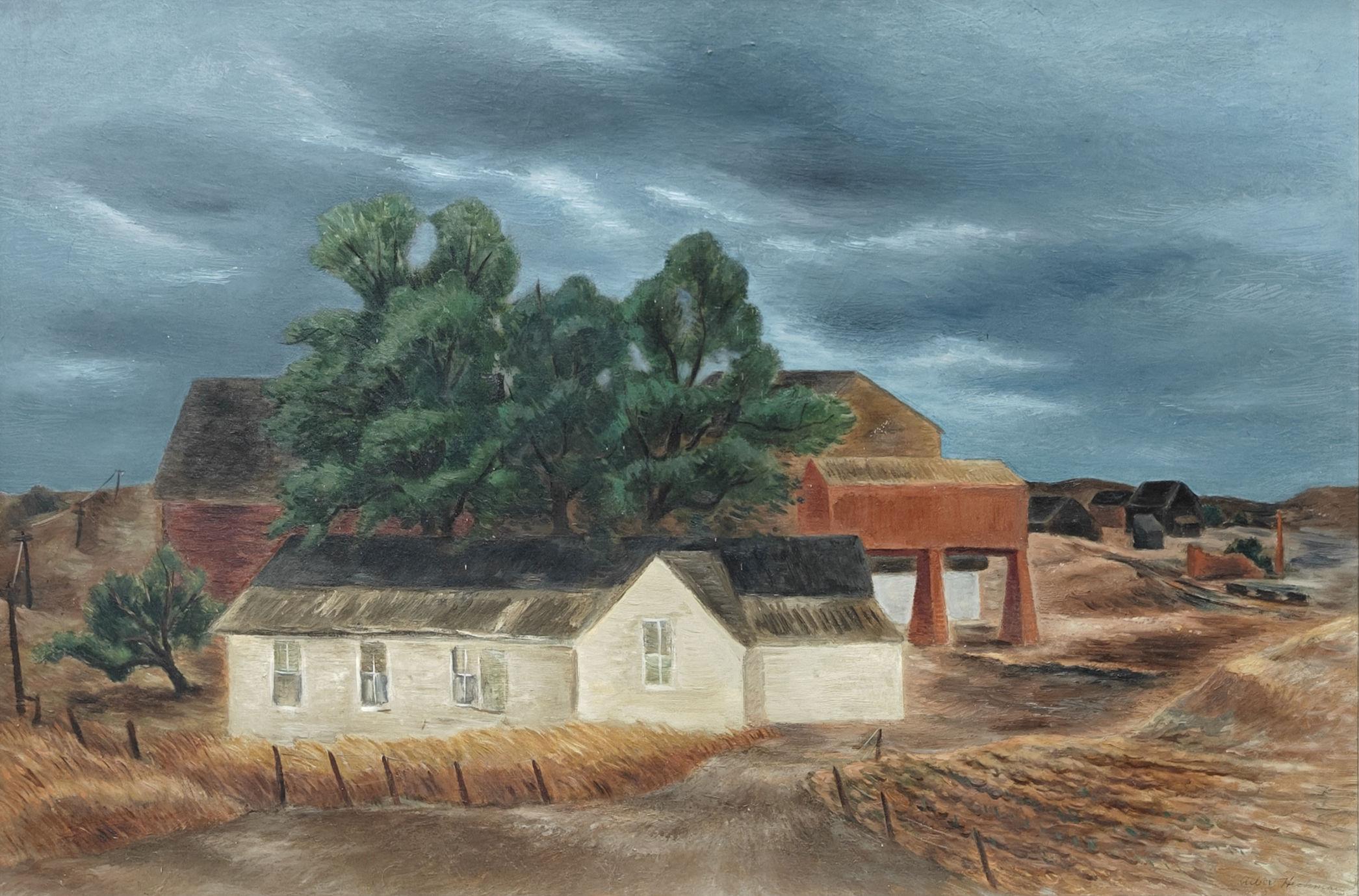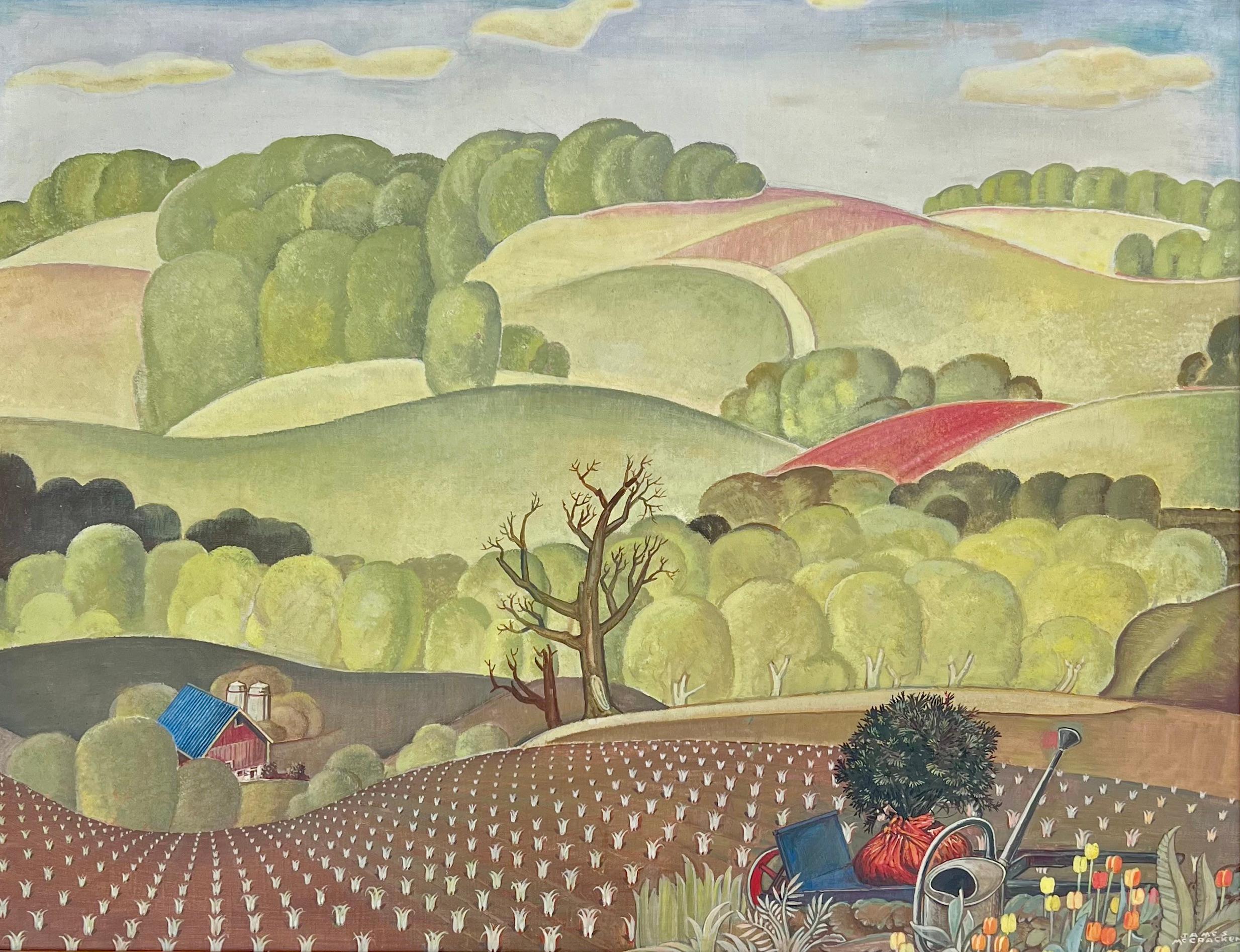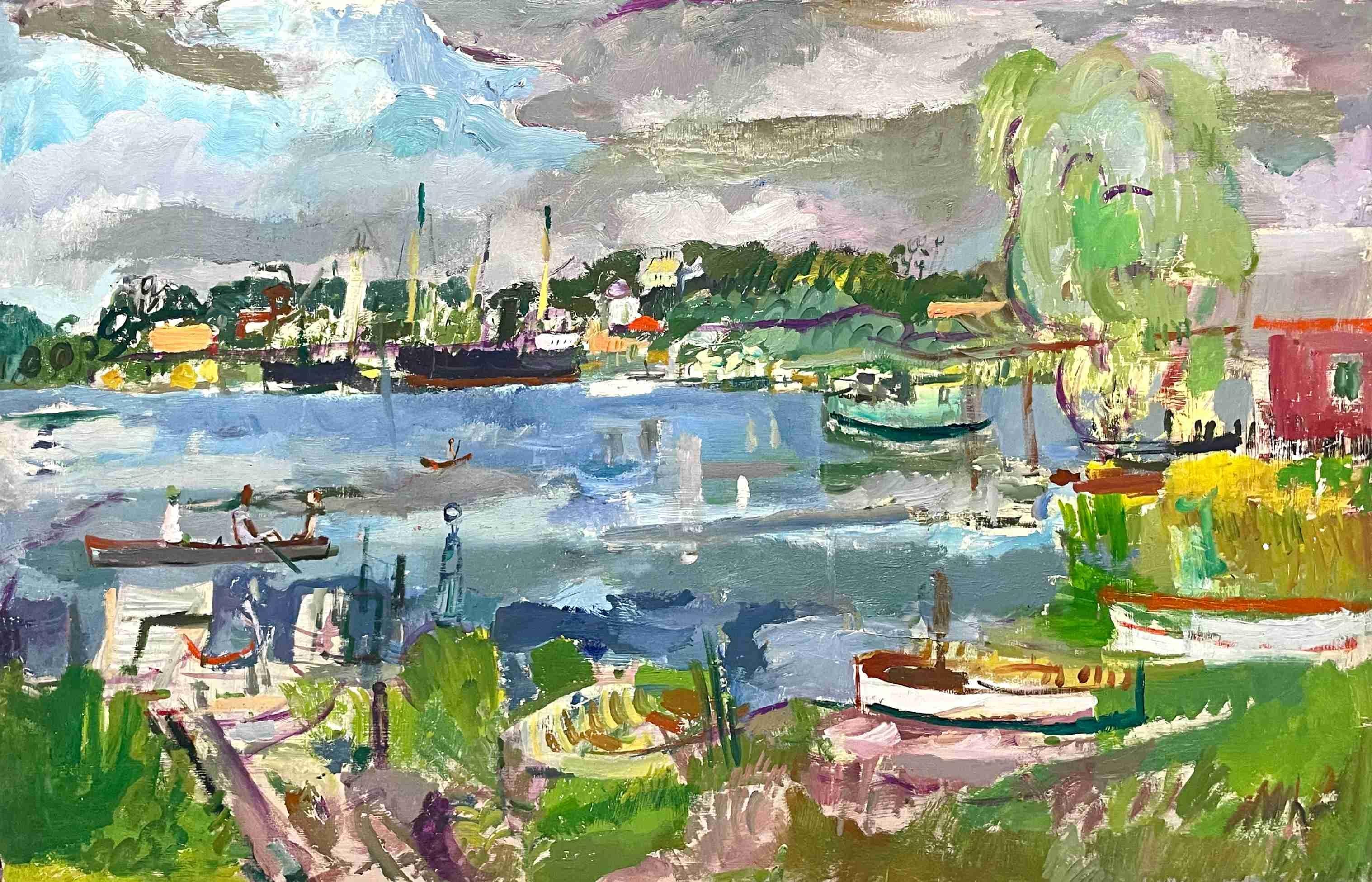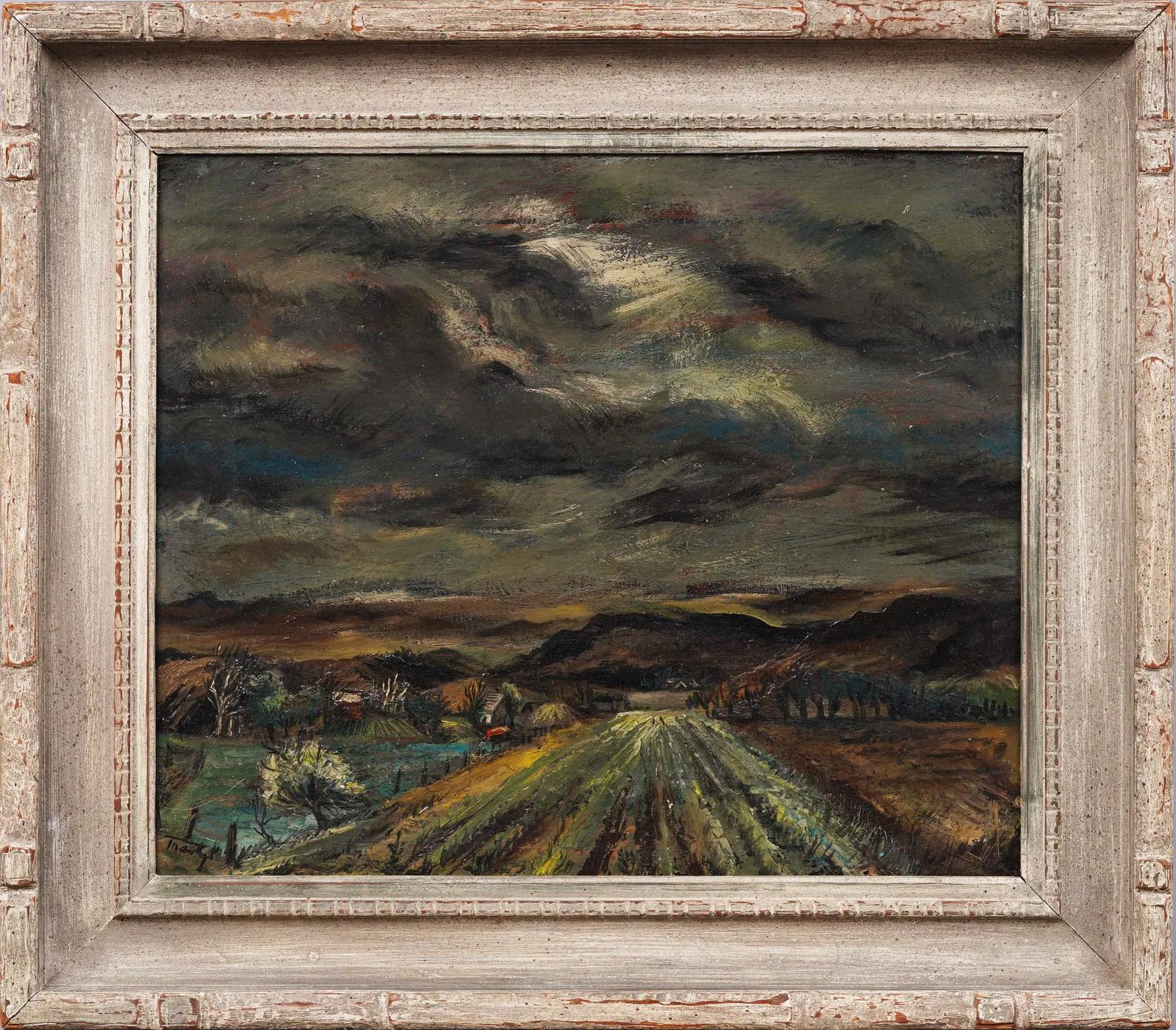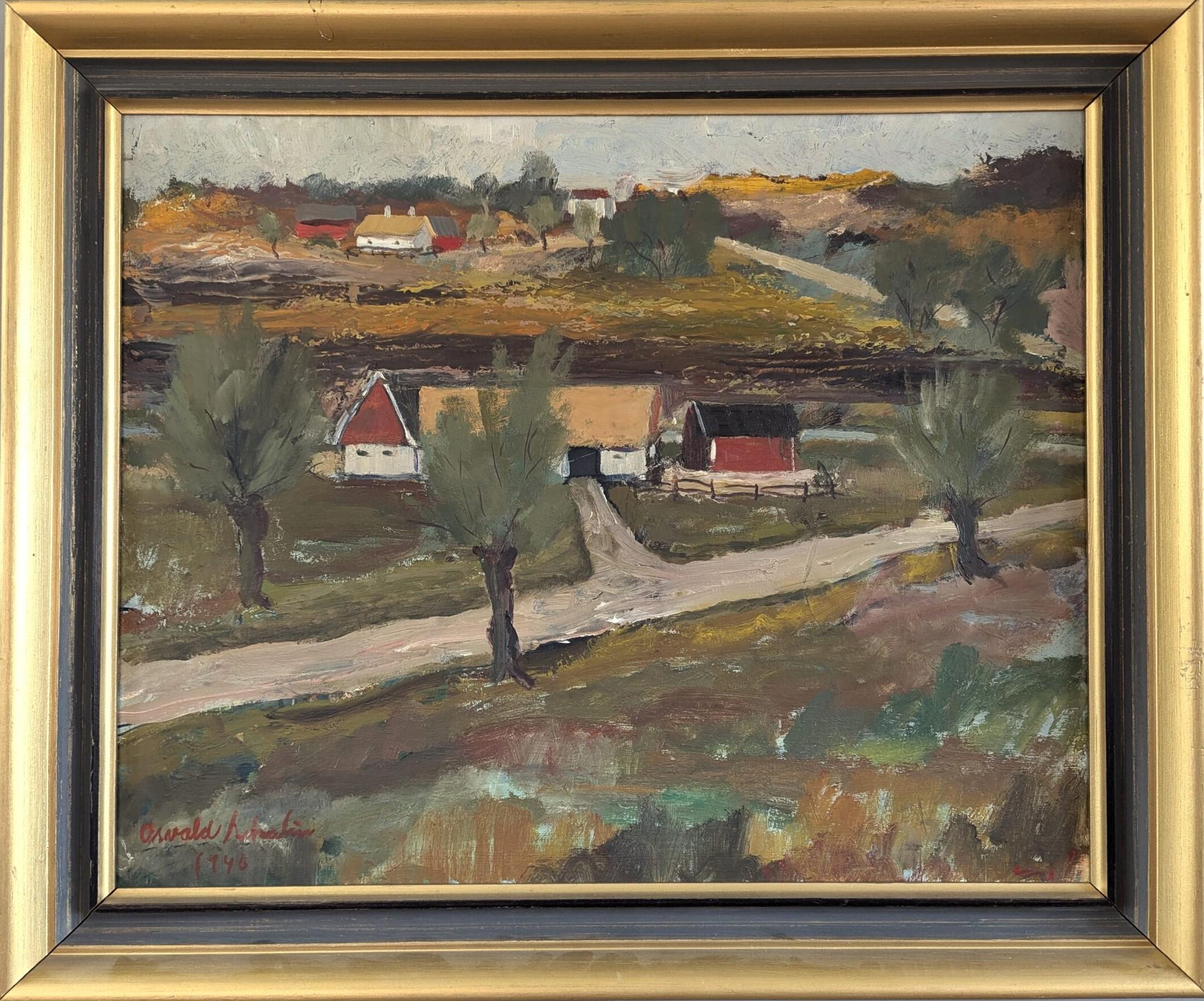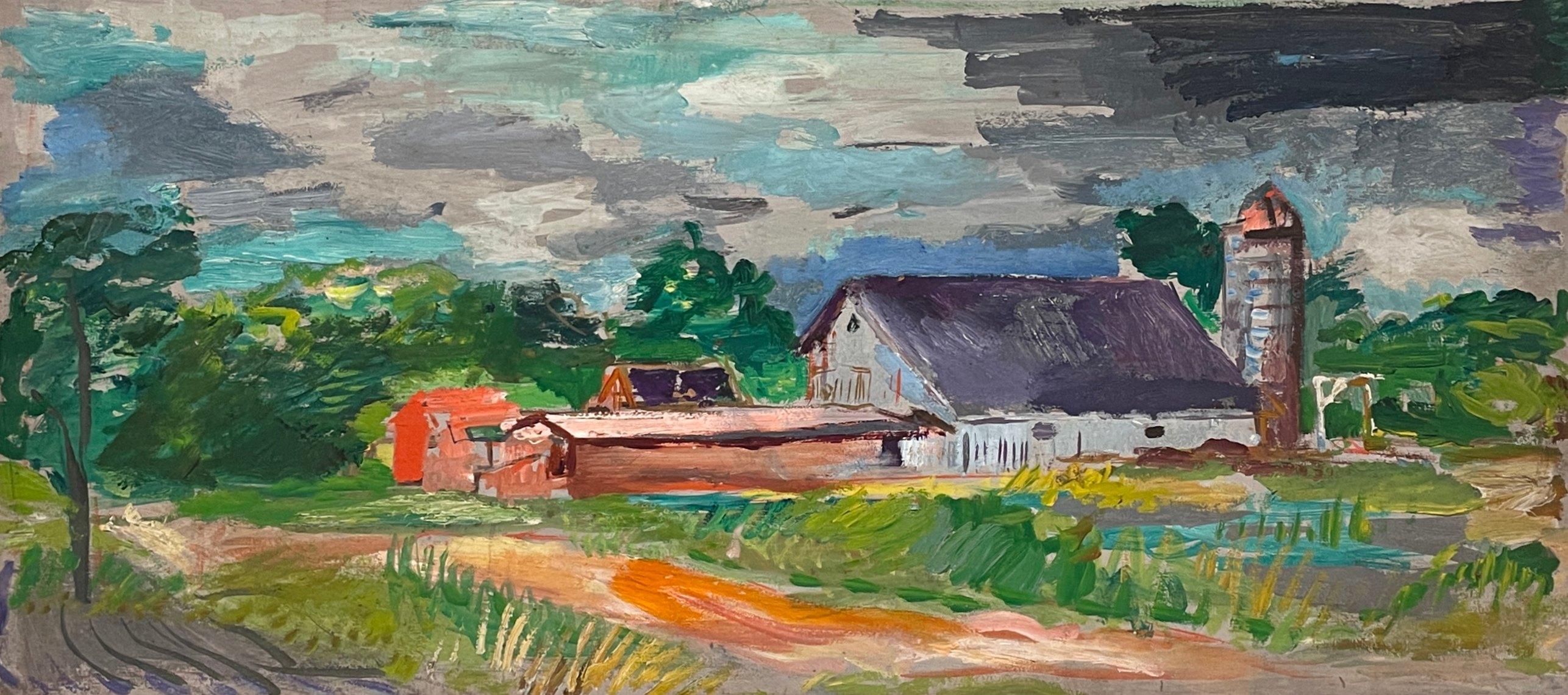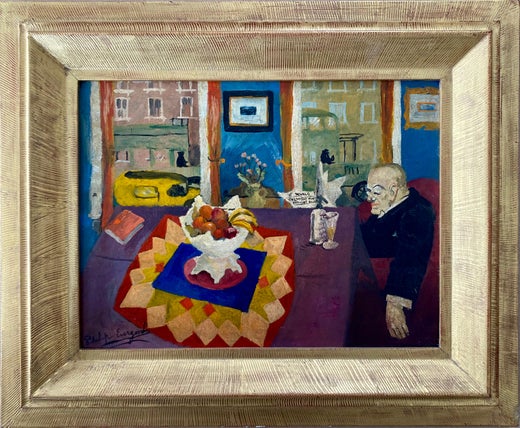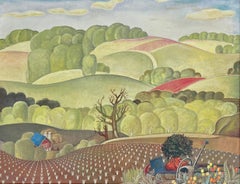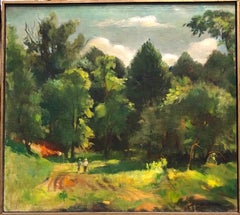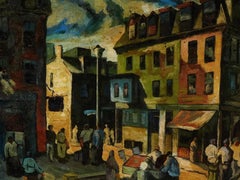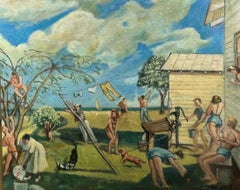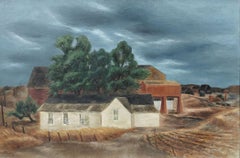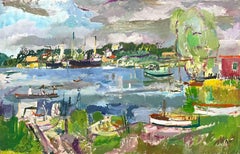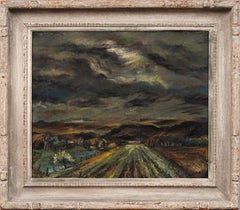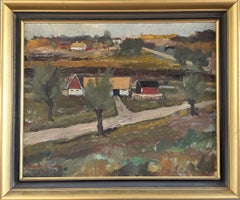Items Similar to "Great Neck Landscape" American Scene Social Realism Mid 20th Century Modern WPA
Want more images or videos?
Request additional images or videos from the seller
1 of 10
Philip Evergood"Great Neck Landscape" American Scene Social Realism Mid 20th Century Modern WPAc. 1935
c. 1935
$28,000
£21,164.53
€24,321.81
CA$38,989.83
A$43,374.59
CHF 22,737.50
MX$530,026.85
NOK 289,533.71
SEK 272,555.93
DKK 181,553.06
Shipping
Retrieving quote...The 1stDibs Promise:
Authenticity Guarantee,
Money-Back Guarantee,
24-Hour Cancellation
About the Item
"Great Neck Landscape" American Scene Social Realism Mid 20th Century Modern WPA
PHILIP HOWARD EVERGOOD (1901 - 1973)
Great Neck Landscape
12 x 16 inches
Oil on board, circa 1935.
Signed at lower right
Framed: 17 x 21 inches
BIO
Philip Evergood was born in New York City on October 26, 1901. His father, an artist named Meyer Blashki, was an Australian Jew of Polish descent who had emigrated to the United States, but his mother was a member of a well-to-do Anglican family who was determined to have her son educated in her native England. When Philip failed to get past the Committee of Admirals for entrance into the Royal Naval Training College, his father fired off an angry letter to the First Lord of the Admiralty Winston Churchill, demanding to know whether the boy's last name had influenced the admirals. Convinced that it had, Meyer Blashki renamed himself and his son Evergood and the boy duly did time at both Eton and Cambridge. But Cambridge and Philip did not long agree, for he finally made up his mind that all he wanted to do was paint.
He studied art at the Slade School in London, Julian Academie in Paris, and the Art Students' League of New York. He met his wife Julia in Paris and they eventually settled in Manhattan. On canvas, Evergood's figures were apt to be as chunky as himself, his colors applied in solid, intrically designed blocks. But the mood could be as soft as a glow. Occasionally Evergood would vent his rage against the world in brilliant clashing clutters of symbolic figures. But there remains an almost childlike sweetness that he had never been able to outgrow.
During the 1930s he was a muralist for the Works Progress Administration and was President of the New York Artists Union. He taught at various institutions in the 1940s and in 1952 moved to Southbury, Connecticut and two years later to Bridgeport where he lived until his death in 1973.
- Creator:Philip Evergood (1901-1973, American)
- Creation Year:c. 1935
- Dimensions:Height: 17 in (43.18 cm)Width: 21 in (53.34 cm)Depth: 2 in (5.08 cm)
- Medium:
- Movement & Style:
- Period:
- Condition:
- Gallery Location:New York, NY
- Reference Number:1stDibs: LU1156215847242
Philip Evergood
Philip Evergood was an American Social Realist painter. An advocate for civil rights, much of his work depicted the daily lives of working-class people, as seen in his hallmark piece, Sunnyside of the Street (1950). “Actually if you paint a group of country folk having a feast like Brueghel did it's social painting, too,” the artist said. “But then when you get down to paintings like The Massacre of the Innocents (1566) by Brueghel when Holland was occupied by the Spanish and you have people smashing doors down and bringing out infants and cutting them in half with swords then you're doing a very brave kind of social statement.” Born Howard Blashki in 1901 in New York, NY, his father was the Australian landscape painter Miles Evergood. It was his father that anglicized the family name from the Jewish-Polish Blashki to Evergood, when Philip was a child. Moving with his parents to London in 1909, he went on to study at Eton College and Cambridge University. Set on pursuing a career in art he enrolled at the Slade School of Fine Art, studying under Henry Tonks. Returning to New York in 1923, he studied with the Ashcan School painter George Luks. During the Great Depression, the artist worked for the WPA, creating murals in both Queens, NY, and Jackson, GA. Evergood died in 1973 in Bridgewater, CT. Today, his works are included in the collections of the Art Institute of Chicago, The Museum of Modern Art in New York, the National Gallery of Art in Washington, D.C., and the Los Angeles County Museum of Art.
About the Seller
5.0
Gold Seller
Premium sellers maintaining a 4.3+ rating and 24-hour response times
Established in 2008
1stDibs seller since 2019
193 sales on 1stDibs
Typical response time: <1 hour
- ShippingRetrieving quote...Shipping from: Pawling, NY
- Return Policy
Authenticity Guarantee
In the unlikely event there’s an issue with an item’s authenticity, contact us within 1 year for a full refund. DetailsMoney-Back Guarantee
If your item is not as described, is damaged in transit, or does not arrive, contact us within 7 days for a full refund. Details24-Hour Cancellation
You have a 24-hour grace period in which to reconsider your purchase, with no questions asked.Vetted Professional Sellers
Our world-class sellers must adhere to strict standards for service and quality, maintaining the integrity of our listings.Price-Match Guarantee
If you find that a seller listed the same item for a lower price elsewhere, we’ll match it.Trusted Global Delivery
Our best-in-class carrier network provides specialized shipping options worldwide, including custom delivery.More From This Seller
View AllWPA Landscape American Scene Social Realism Mid 20th Century Modern Farm Rural
By James McCracken
Located in New York, NY
WPA Landscape American Scene Social Realism Mid 20th Century Modern Farm Rural
James McCracken (1875 – 1967)
WPA Landscape
28 x 36 inches
Oil on canvas, c. 1930s
Signed lower right
...
Category
1930s American Modern Landscape Paintings
Materials
Canvas, Oil
Landscape American Hungarian European Modernism 1938 Realism Long Island WPA era
By Stephen Csoka
Located in New York, NY
Landscape American Hungarian European Modernism 1938 Realism Long Island WPA era. The canvas measures 18” x 20". The artist signed the stretcher as well as the canvas.
The scene depicts a spots in New York where Queens borders with Nassau county, Rosedale, which abuts the Five Towns. The border runs through Hook Creek, another painting we are currently offering.
Stephen (Istvan) Csoka was born in Gárdony, Hungary on January 2, 1897 and died in New York in 1989. He is best remembered as a painter and etcher of portraits, nudes, landscapes, genre, and horses. Csoka studied at the Budapest Royal Academy of Art and his memberships include Associate of the National Academy of Design in New York City; the Society of American Etchers in Brooklyn, NY; the Society of Brooklyn Artists; and the Hungarian Etchers Association.
Csoka's exhibitions and awards include a medal at the Barcelona International Exhibition in 1929; a prize at the City of Budapest Exhibit in 1930; prizes at the Society of American Etchers in 1942 and 1945; prizes at the Library of Congress in 1944 and 1946; a prize at the Society of Brooklyn Artists in 1944; a prize at the Philadelphia Watercolor Club in 1945; the Corcoran Gallery of Art in 1945; the Carnegie Institute in 1943, 1944, and 1945; the Art Institute of Chicago in 1944; the Los Angeles Museum of Art in 1945; the National Academy of Design from 1940 through 1945; one-artist shows at the Contemporary Artists in 1940, 1943, and 1945; and the Minneapolis State Fair in 1943. *Stephen continued to recieve awards and exhibit his work throughout his life. In 1997, Hofstra Museum sponsored a Retrospective/Centennial exhibition in honor of his birth.
Collections representing Csoka's work are the Metropolitan Museum of Art, New York, NY; the Brooklyn Museum, Brooklyn, NY; the Museum of Fine Arts, Boston, MA; the British Museum, London, England; the Bezalel National Museum, Jerusalem, Israel; the Butler Institute of American Art, Youngstown, Ohio; Whistler House Museum of Art, Lowell, MA; the Cleveland Museum of Art, Cleveland, OH; Columbus Museum of Art, Columbus, OH; the Sheldon Swope Art Museum, Terre Haute, IN; the Mobile Museum of Art, Mobile, AL; the Frederick R. Weisman Art Museum, Minneapolis, MN; the Museum of New Mexico, Santa Fe, NM; the Budapest Museum of Fine Arts, Budapest, Hungary; Hungarian National Gallery, Budapest, Hungary, the Museum of the City of Budapest, Budapest, Hungary; the Library of Congress, Washington, DC; Carnegie Museums of Pittsburgh, Pittsburgh, PA; the Chrysler Museum of Art, Norfolk, VA; Georgia Museum of Art, Athens, GA; Hofstra Museum, Hofstra University, Hempstead, NY; Holocaust Museum, Glen Cove, NY; National Academy of Art, New York, NY; New Orleans Museum of Art, New Orleans, LA; New York Historical Society, New York, NY;New York Public Library, New York, NY; National Gallery of Art, Washington, DC; Peabody Museum, Cambridge, MA; Pennsylvania Academy of the Fine Arts, Philadelphia, PA; Reading Public Museum, Reading, PA; Livingston Arts Center, Mount Morris, NY; Ball State Teachers College, Muncie, IN; City College, New York, NY; Fashion Institute of Technology, New York, NY; Hungarian Consulate, New York, NY; Hungarian Heritage, New Brunswick, NJ; Hunter College, New York, NY; IBM Collections; Princeton Print Club...
Category
1930s Realist Landscape Paintings
Materials
Canvas, Oil
Cityscape Mid-20th Century Modern Social Realism American Scene Regionalism WPA
Located in New York, NY
Cityscape Mid-20th Century Modern Social Realism American Scene Regionalism WPA
Samuel Thal (1903 to 1964)
"Cityscene"
12 x 16 inches
Oil on board, c. 1940s
Signed verso
Framed: 19...
Category
1940s American Modern Figurative Paintings
Materials
Board, Oil
A Summer Day WPA American Scene Social Realism Modern Ashcan Early 20th Century
By Leon Kroll
Located in New York, NY
A Summer Day WPA American Scene Social Realism Modern Ashcan Early 20th Century
Leon Kroll (1884-1974)
"A Summer Day"
14 x 17 inches (image...
Category
1930s Figurative Paintings
Materials
Oil, Board
"Summer Pier Fishing" American Scene Social Realism WPA Mid-20th Century Modern
Located in New York, NY
"Summer Pier Fishing" American Scene Social Realism WPA Mid-20th Century Modern
Syd J. Browne (1907-1991)
"Summer Pier Fishing"
22 x 30 inches
Oil on canvas. c. 1930s
Signed lower r...
Category
1930s American Realist Figurative Paintings
Materials
Canvas, Oil
"Streetscape" American Scene WPA Social Realism Mid 20th Century Industrial
Located in New York, NY
"Streetscape" American Scene WPA Era Social Realism Mid 20th Century Industrial
Herbert Heyel (American 1907-2000)
"Streetscape"
14 x 20 inches
Watercolor on paper, c. 1939
Signed l...
Category
1930s American Realist Landscape Drawings and Watercolors
Materials
Paper, Watercolor
You May Also Like
"Glasco Landscape" Albert Heckman, circa 1940 New York Modernist Landscape
By Albert Heckman
Located in New York, NY
Albert Heckman
Glasco Landscape, circa 1940
Signed lower right
Oil on canvas
25 1/4 x 39 1/2 inches
Albert Heckman was born in Meadville, Western Pennsylvania, 1893. He went to New York City to try his hand at the art world in 1915 after graduating from high school and landing a job at the Meadville Post Office. In 1917, at the age of 24, Heckman enrolled part-time in Teachers' College, Columbia University's Fine Arts Department to begin his formal art education. He worked as a freelance ceramic and textile designer and occasionally as a lecturer at the Metropolitan Museum of Art. In the early 1920s, at the age of almost 30, he graduated with a Bachelor of Arts degree from Columbia Teachers College. He was especially impacted by his instructor at Columbia, Arthur Wesley Dow.
After graduating, he was hired by the Teachers' College as a Fine Arts instructor. He stayed with Columbia Teachers' College until 1929, when he left to attend the Leipzig Institute of Graphic Arts in Leipzig, Germany. Isami Doi (1903-1965), who was born in Hawaii, was arguably his most impressive student at Columbia. Doi is now regarded as one of the most prominent artists hailing from Hawaii. Heckman became an active member and officer of the Keramic Society and Design Guild of New York in the 1920s as part of his early commercial art career. The Society's mission was to share knowledge and showcase textile and ceramic design exhibits.
In 1922, Heckman married Florence Hardman, a concert violinist. Mrs. Heckman's concert schedule during the 1920s kept Albert and Florence Heckman apart for a significant portion of the time, but they spent what little time they had together designing and building their Woodstock, New York, summer house and grounds. A small house and an acre of surrounding land on Overlook Mountain, just behind the village of Woodstock, were purchased by Albert and Florence Heckman at the time of their marriage. Their Woodstock home, with its connections, friendships, and memories, became a central part of their lives over the years, even though they had an apartment in New York City.
Heckman's main artistic focus shifted to the house on Overlook Mountain and the nearby towns and villages, Kingston, Eddyville, and Glasco. After returning from the Leipzig Institute of Graphic Arts in 1930, Mr. Heckman joined Hunter College as an assistant professor of art. He worked there for almost thirty years, retiring in 1956. Throughout his tenure at Hunter, Mr. Heckman and his spouse spent the summers at their Woodstock residence and the winters in New York City. They were regular and well-known guests at the opera and art galleries in New York. Following his retirement in 1956, the Heckmans settled in Woodstock permanently, with occasional trips to Florida or Europe during the fall and winter. Mr. Heckman's close friends and artistic career were always connected to Woodstock or New York City. He joined the Woodstock art group early on and was greatly influenced by artists like Paul and Caroline Rohland, Emil Ganso, Yasuo Kuniyoshi, Andre Ruellan, and her husband, Jack...
Category
1940s American Modern Figurative Paintings
Materials
Canvas, Oil
A Large, 1950s, Oil on Masonite Painting of a Michigan Harbor by Francis Chapin
By Francis Chapin
Located in Chicago, IL
A lovely summer day in a ca. 1950s Lake Michigan harbor, perhaps in Saugatuck, Douglas or at Oxbow! This is a large oil on Masonite painting by notable artist Francis Chapin that is...
Category
1950s American Modern Landscape Paintings
Materials
Masonite, Oil
Important Regionalist WPA Modern Framed And Signed Landscape Oil Painting
By Martyl Suzanne Schweig Langsdorf
Located in Buffalo, NY
Modernist landscape oil painting by Suzanne Schweig Langsdorf Martyl (1917/18 - 2013). Oil on board. Signed. Framed. Measuring 28 by 32 inches overall and 20 by 24 painting alone.
Category
1940s Modern Landscape Paintings
Materials
Canvas, Oil
1946 Mid-Century Modern Expressive Landscape Oil Painting - Rural Tranquility
Located in Bristol, GB
RURAL TRANQUILITY
Size: 60.5 x 72 cm (including frame)
Oil on board
A tranquil mid-century landscape composition, executed in oil onto board and dated 1946.
The painting captures a...
Category
Mid-20th Century Modern Landscape Paintings
Materials
Oil, Board
A Picturesque ca. 1940s Farm Scene with a Barn & Silo by Artist Francis Chapin
By Francis Chapin
Located in Chicago, IL
A picturesque ca. 1940s, horizontal farm scene with a barn & silo, created in oil on Masonite, by Artist Francis Chapin. Painting likely depicts Wisconsin or Michigan. Painting is ...
Category
1940s American Modern Landscape Paintings
Materials
Masonite, Oil
American Regionalist Landscape Painting by Very Talented Mystery Artist Signed
Located in San Francisco, CA
American Regionalist Landscape Painting by Very Talented Mystery Artist
Signed Lower Right
Early 20th century
In good vintage condition with areas of paint loss
Oil on Canvas
...
Category
20th Century Landscape Paintings
Materials
Canvas, Oil
Read More
Ludwig Bemelmans Captures the Thrilling Sight of Coney Island at Night
The ‘Madeline’ creator and Carlyle Hotel legend was in a New York state of mind in the 1940s when he produced this exuberant and rare oil painting.
Mid-Century Americans Didn’t Know Antonio Petruccelli’s Name, but They Sure Knew His Art
The New York artist created covers for the nation’s most illustrious magazines. Now, the originals are on display as fine art.
More Ways To Browse
C Howard
Churchill Winston
Churchill Vintage
Howard Midcentury Modern
A Churchill Painting
Winston Churchill Paintings
Coaching Scene
Midnight Sun
Paul Waters
Ship Painting Storm
Thomas Daniel
Vertical Oil Paintings Trees
Bucks County Oil
Cows Grazing
Hansen Oil Paintings
Hastings Landscape
Japanese Farm
Joseph Banks
